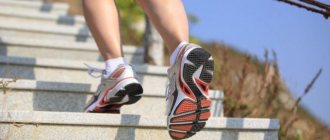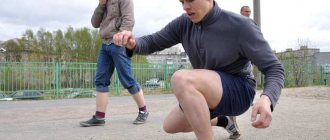Playing sports and being in great physical shape is the dream of many people. However, not everyone can afford to purchase a gym membership, and the conditions for independent training do not always meet the desired requirements.
Let's say you decide to start running, but there is not a single park near your house, the weather is not conducive to exercise, or there is not enough space in your apartment for a treadmill.
Many, faced with such difficulties, shelve the dream of a slim figure, or even never return to it. And they don’t know that literally outside their door there is an excellent sports machine that can help you get rid of extra pounds in the shortest possible time.
You've probably already guessed what we're talking about, and maybe you've even heard about this type of cardio exercise, like running up the stairs.
It is accessible to absolutely everyone and has a lot of advantages. Let's figure out which ones exactly. Don't put it off until tomorrow, START running today!
Running group “START” - from 0 to 5 km. per month
More details
How can running up the stairs help?
If we compare the load that the body receives during normal running on mostly flat terrain, then when running up stairs the impact increases significantly. The degree of exercise received is even higher than running on an inclined treadmill.
Such a high degree of impact occurs because the speed of movement on stairs is higher than on a flat surface. Moreover, if during normal running the push-off is made forward, then when running along a protruding surface, each push-off is directed upward.
As a result of prolonged work in high intensity mode, you can get the following results:
- The number of calories burned increases;
- Subcutaneous fat is burned faster;
- Muscles become stronger;
- Areas of the body that attract attention (buttocks, thighs, calves, abs) become aesthetically beautiful;
- The cardiovascular system is trained;
Every barrel of honey has its own fly in the ointment, and, unfortunately, this type of running is not ignored by the rule. When exercising on stairs you may encounter the following problems:
- Tendon tear. Most often in the heel area (Achilles tendon). The unpleasant thing is that the tendons take up to six months to recover, and the pain returns with every physical activity on the damaged area. You can speed up healing and relieve pain by using an elastic bandage. You can tear a tendon by tripping or slipping your foot.
- Crick. A popular problem for all sports fans. Running up stairs can stretch your inner thigh. Heals within 2-3 weeks and requires an elastic bandage.
- Back pain. If you lean too far forward while running, you may experience discomfort in the lumbar region. Therefore, keep your back straight. If your back still hurts, then again use an elastic bandage and warming ointments.
It will also be useful to know in which cases running up stairs is not recommended:
- High degree of obesity. Most likely, if you have a high degree of excess fat, doing this type of exercise simply won’t work.
- Scoliosis grade 2 and higher. With the first degree of scoliosis, it is not recommended to build the entire workout using the stairs as the only exercise machine. In the case of grade 2 and above, such a load is prohibited.
- Phlebeurysm. It is not a strictly prohibiting reason, but it is still better to abstain. High load on the legs with varicose veins causes its further development.
- Hypotonics and hypertensives need to be careful. If deviations from normal pressure are associated not with individual characteristics, but with a disease, then it is better to refrain from such a load.
- Heart diseases. If there are disturbances in the functioning of the cardiovascular system or defects, prolapses and other heart problems, it is not recommended to engage in high-intensity exercise.
The best option for running stairs is the absence of any health problems. The best solution would be to fully recover from illness and completely heal injuries before resorting to this exercise.
How to start training
The first training session may be short. You shouldn't torture yourself with a grueling run. If you feel like you have no strength left, it is recommended to stop or take a long break.
Warm-up
Simple exercises will help warm up your muscles.
There is no need to devote a lot of time to warming up; its purpose is to prepare for the main workout.
If you wish, you can do a number of other exercises:
- squats;
- jumping in place;
- swing your legs back.
Core workout
The main training starts from the top, that is, the person goes down. You can start by walking slowly and gradually speed up. It is not recommended to run too fast, jumping from the middle of the steps: this can lead to injury.
Toes should be pointed straight and hands clasped. When walking quickly, you can hold on to the handrails on the stairs.
Hitch
A cool-down is a gradual reduction in physical activity. It is advisable to switch to fast walking or slow running down the stairs. It is not recommended to end your workout by lifting yourself up.
Stair running technique – what are its features?
If you are familiar with various types of running, be it sprint or distance running, then you know that each discipline has its own distinctive features in technique. In the case of running up stairs, the differences lie in the speed of performing technical elements.
As an example, you can compare running up stairs with sprinting. If you pay attention to the speed of movement, then in the first option it can be 2-3 times higher than in the second. This means that to better master the technique you need to have high precision movements. Any mistake when running up stairs can cause injury. However, this has always been the case in every sport.
Technical elements
The position of the head, arms and torso remains the same as in sprinting. The foot is also placed on the toe, and the heel does not touch the surface. Try to place your foot approximately in the middle of the threshold so as not to slip or stumble during the subsequent push-off. The gaze is directed down the stairs.
Varieties of running
You can run by stepping on each step or after 1-2 steps. If the goal of your workout is to burn as many calories as possible, then the first option without skipping steps is a good choice. With this option, the frequency of movements will be significantly higher, which will cause high sweating due to frequent contractions of muscle fibers.
The second option with skipping steps is suitable for strengthening and even pumping up muscles. In this case, for each repulsion it will be necessary to apply significantly more force.
Despite the variety of options, the increase in heart rate in both cases will be approximately the same and high. The average heart rate when exercising on the stairs can reach 150-160 beats per minute. Some lovers of this kind of running can easily accelerate their heart rate to a maximum of 200-210 beats.
ARE THERE ANY RISKS/THINGS TO WATCH FOR?
This is the type of activity an athlete would want to do at the beginning of training. Whether you're doing strength training or running, do your stair workout before you feel tired. The safest way to train on stairs is to start with a short warm-up followed by a workout.
When performing any type of jumping, do not start from a high object, exceeding the height of mid-shin. Develop good ground clearance and a soft landing at this height before proceeding.
Stair running program
Typically, the entrances of residential buildings are not conducive to sports activities, as they have a high degree of tobacco smell and disgruntled neighbors. Therefore, the option would be to exit to the stadium or any high stairs that are located on the street.
Usually, running does not require a warm-up, because most often this sport itself is one. But in our case, it would be better to take time to warm up the muscles. The easiest option would be to jog on a flat surface for 5-10 minutes at a slow pace with slight accelerations. If desired, you can perform bends and special running exercises to be more confident in the physiological readiness of the body for the load.
In order for running up the stairs to bring visible benefits, you must follow the correct dosage.
The total training time per week should be 1.5-3 hours. This time can be divided into at least 3 and maximum 5 days. There must be rest days during the week, but their number should not exceed 2 days.
The optimal training mode would be to run to the top point with maximum intensity, and descend slowly on foot. In the future, you can try a faster but more careful descent.
Sample training program for 3 days
| Monday | 25 minutes |
| Wednesday | 35 minutes |
| Friday | 40 minutes |
| Total time: 1 hour 40 minutes | |
Approximate training program for 5 days
| Monday | 30 minutes |
| Tuesday | 30 minutes |
| Thursday | 40 minutes |
| Friday | 35 minutes |
| Sunday | 20 minutes |
| Total time: 2 hours 35 minutes | |
Immediately discard thoughts that exceeding the proposed dosage will speed up the process of achieving results. If you have a question, it is better to leave it in the comments and get recommendations to speed up the process.
Examples of running exercises on stairs
Option 1
This training is a type of general developmental exercise. A flight of 10 steps is suitable for her. The training consists of a set of exercises:
- warm-up 10 minutes;
- easy run up each step;
- speed running on each step;
- two approaches of running over a step;
- two sets of running (slow rise) through two steps;
- side run. first one side, then the other;
- easy run up each step.
One block of exercises takes on average 5-6 minutes. Perform 3-5 of these blocks and stretch.
This is interesting
- [uaf_vkcount url='https://beginogi.ru/formula-karvonena-dlya-rascheta-zhiroszhigayushhey-chastotyi-pulsa/']
Karvonen formula for calculating fat burning heart rate
- [uaf_vkcount url='https://beginogi.ru/polar-luchshie-chasyi-s-pulsometrom-dlya-bega-obzor-modelnogo-ryada-polar/']
Polar is the best heart rate watch for running. Overview of the Polar range
Option 2
Mixed walking/running workout. The essence of this workout is to develop functional endurance while increasing volume.
After a 10-minute warm-up, begin alternating 1 flight - walking, 1 flight - running. To begin with, it is better to perform 4-6 flights, then, as you progress, reach 12-14 flights. Go downstairs with a light jog, restore your heart rate to at least 130 beats/min. and repeat 4-5 more approaches.
In the future, increase the total number of flights of stairs, vary the number of walking and running stairs. As a result, bring your total long workout to at least 30 minutes.
Option 3
Speed-strength training.
After warming up, we run for 2-4 flights, do a choice of strength exercises at the top: simple squats, jump squats, burpees, push-ups, etc., go down to the bottom and recover. The total duration of the lesson is about 30 minutes, so it is better to divide it into a block of 4-5 repetitions.
Alternate these types of exercises with regular jogging, include other types of loads in your training program, and good results will not keep you waiting.
Which shoes to choose?
Shoes with shock-absorbing soles are best for running on raised surfaces. Such shoes protect joints well from the shock load that occurs when running, and in our case the load will be even higher.
Avoid sneakers and other shoes with thin soles; for running up stairs you should use sneakers. The main criteria for sneakers in this case will be:
- Lightweight (within 500 grams). The lighter the shoe, the better;
- The toe should bend easily;
- It is advisable that the sole be made of filayte or phylon.
Lace up your sneakers as tightly as possible - and go ahead to conquer the peaks. And this time literally!
Main rules of training
- Always make a training plan, gradually increasing the time and increasing the intensity.
- Before each workout, do a full warm-up.
- For the first couple of workouts, do not run, but walk to avoid severe soreness.
- Depending on the number of steps, we recommend limiting yourself to 10 ascents and descents per training block. This 20-30 minute workout is as effective as a regular running workout.
- Add stair running to your workout routine on high-intensity days or mix it up with interval training.
- The running technique involves breathing through the nose. If you are short of breath, reduce the intensity of your workout to catch your breath.
Steps as a means of subsistence
They will bring a lot of joy to your life:
- This will strengthen your cardiovascular system, leg and abdominal muscles. You can easily cover walking distances on the way to work, during excursions and hikes.
- By strengthening your body, you will achieve respect in the team you work with. Representatives of the opposite sex will watch with admiration as you bravely jump onto the top floor to meet the boss.
- Book or computer weekends will be replaced by relaxation in nature, because the energy that the body will store will not allow you to stay at home, and running will become a hobby for you.











